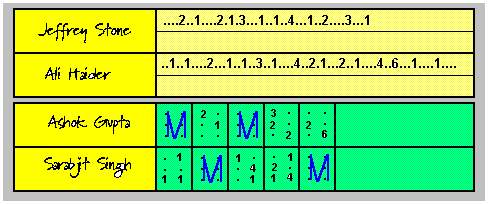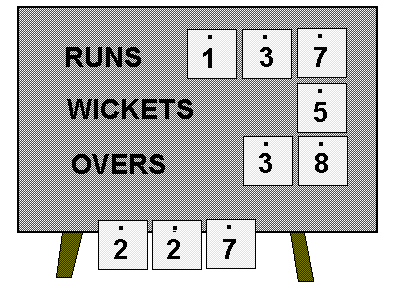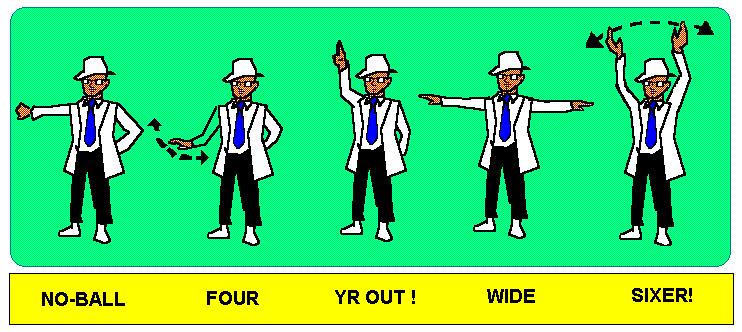
Introducing CRICKET EQUIPMENT
If you have never seen cricket before, some of the equipment may be unfamiliar to you.
Here is a look at what cricketers use...the equipment, materials, and other things that make up the game.
TABLE OF CONTENTS
Click on any item below to go directly to it.
Click on "Back" to get back to the top of the Table of Contents.
THINGS WORN BY CRICKETERS

Only the BATTER (called the BATSMAN in cricket) and the WICKETKEEPER (cricket's term for baseball's CATCHER) are allowed to wear protective equipment on the field.
The Batsman wears leg guards , batting gloves, and can also wear protective equipment under their clothing to shield their chest, upper thigh (the one facing the bowler, or pitcher) and crotch area. He can also wear a helmet, especially against fastballs, but often wears only a cap when the slower bowlers are on.
The Wicket Keeper also wears leg guards, more padded and bulky than "batting leg-guards". He also wears wicket-keeping gloves, which are really two sets of gloves...an inner one of soft cotton, and an outer one of heavily padded, rubber, leather or vinyl...calculated to heep his "catching hands" un-bruised through several hundred pitches ! Some wicket-keepers wear other items. such as helmets or body protectors, but this is not yet the norm.
Back
CRICKET BALL AND BAT

The CRICKET BALL is, inside, very much like baseball's hardball...a wrapped cork center, weighing about 5-3/4 ounces. Outside, however, it is polished smooth...usually red, but white balls are used for night games and in the World Cup. It also has a singleheavy seam running around it, unlike baseball's "S" seam which curves around the ball.
The cricket pitcher (bowler) , by changing the angle of the seam in his hand, can get varying degrees of movement in the air, such as shallower or deeper curves or sliders...he can also use the seam to get different kinds of "bounce", which is allowed in cricket.
Typically, the same ball must be used all through an inning. In other words, cricket fans cannot keep the balls as souvenirs, as in baseball !
The CRICKET BAT is paddle shaped, with a ridge on the back. This allows the batter in cricket to aim his hits more accurately than in baseball, and even angling the face of the bat for deflection hits to either side.
As in baseball, there are light and heavy bats, and long- and short-handled ones...batters choose bats that suit their style of hitting.
Back
WICKETS AND BAILS

Instead of a home plate to designate the strike zone, cricket has THREE STUMPS, or WICKETS, planted behind the batter..
On top of the sticks, two pieces of wood called BAILS are placed as shown in the diagram. The idea is that if the wickets are touched by a ball, one or both the "bails" will fall to the ground...so there will be no arguments about whether the sticks were hit or not !
The batter has to stop the pitcher from touching any of the sticks with a direct throw....if the sticks are hit, the batter is out (like a strike). TAGS, or RUN-OUTS as they are called in cricket, are also made by touching the wickets before the runner can reach safe ground near the sticks...and again, the "bails" are used to decide for sure whether and when the sticks have been hit.
Back
The CRICKET SCOREBOOK

The scorer in a cricket match uses a SCOREBOOK, using a special code, to keep track of a cricket game in progress.The scorebook is an essential piece of equipment at a cricket game !
The top two rows in the diagram above show how the batters' progress is charted by the scorer.
Each pitch, or delivery, on which no run is scored, is marked with a dot, or period. When a hit is made, the number of runs scored on the hit is entered on the running score. As a result, when the batter is finally "out", it is possible to tally the total number of pitches faced by the batter, and calculate his "strike rate", which is the number of runs scored divided by number of pitches faced.
The bottom two rows show how a bowler's/ pitcher's progress is marked in the scorebook. A dot is entered for every pitch which the batter stops, or leaves alone. When the batter hits the pitch, the runs scored off the pitch are entered in the box.
If a pitcher/bowler has bowled a complete "over" (six pitches) without the batter scoring, it is called a "maiden" over. . The six dots in that over are marked with an "M", so at the end of the game, the "M"s for each pitcher/bowler can be added up to see how many maiden (scoreless) overs he has delivered.
Back
The SCOREBOARD in CRICKET

The picture above illustrates the simplest form of cricket scoreboard, that is typically found in most club matches,
The first row shows the number of runs that has been scored so far by the team that is presently batting. The second rows, titled "wickets", shows how many "outs" have occured...10 outs, it may be recalled, would be the maximum number allowed for an inning.
The line titled "overs" shows how many pitches ( 6 times the number of overs) have been delivered during the current inning. The "over count" is important in "limited-over" matches, where a team may be allowed a maximum number of overs to bat....in the example, which is of a 50-over (300-pitch) limit, the batting team has clearly batted for more than half its allotted overs.
If the other team has already batted, its score is shown along the bottom of the scoreboard, as in thie example. This would then be the score the the team batting has to beat, in order to win the game.
There are more elaborate scoreboards...some showing the current individual scores of both batters who are on the field, others giving the score of the last person to be out. But if you can read the key numbers, you will be able to follow a game in progress.
Back
The CRICKET UMPIRE'S SIGNALS

Umpires might not be considered equipment ! But because cricket umpiring is very unique to the game, the signals used by umpires are included in this section...we hope you find them helpful.
Cricket umpires traditionally wear white jackets, and dark pants, to distinguish them from the rest of the fielders. They are true "judges", rather than controllers of the game as in baseball or football. They signal "outs" only when appealed to, by the cricketer making the play.
Umpires do signal illegal pitches without having to be asked, such as "no-ball" if the pitcher strays too far over the line from which he is supposed to deliver his pitch, or "wide" if the pitch is thrown too far away from the batter to give him a reasonable chance of hitting the ball.
A "no-ball" means the batter cannot be struck out or caught out, and a penalty run is awarded to the batting side. When a "wide" is called, a penalty run is awarded and the pitcher has to make the delivery again...hopefully, closer to the batter.
When a line drive crosses the boundary of the field, or reaches the fence, the umpire signals "four" (meaning, four runs) by waving his right arm. If the hit is skied over the fence, like a home run in baseball, the umpire signals a "sixer" (meaning, six runs) by raising both hands and waving them from side to side.
If you are able to read the umpire's signals, it will help you to follow the game.
Back
Home







